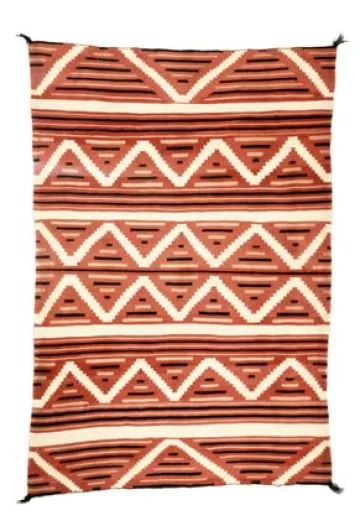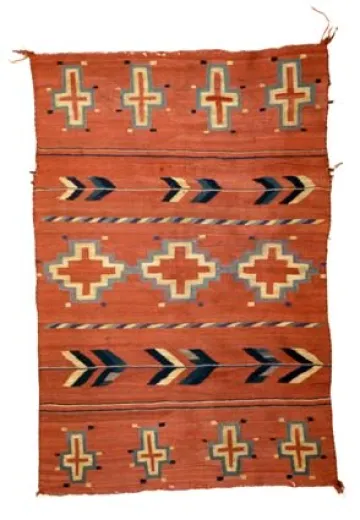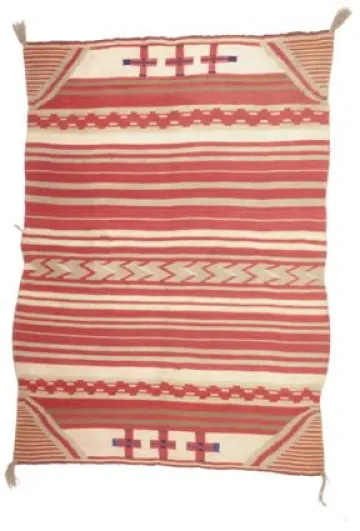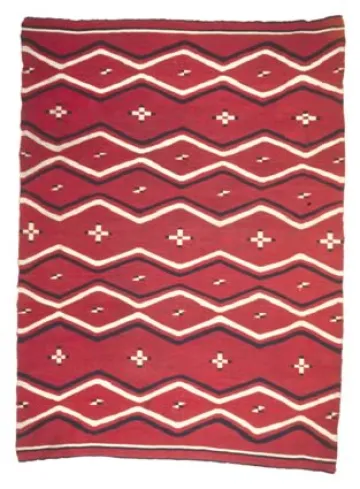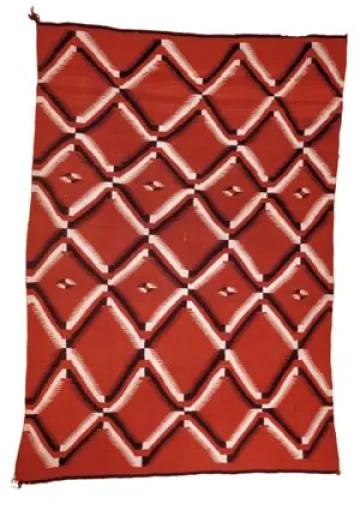
E-2724
Sarape and poncho are Spanish terms used by scholars and collectors for blankets woven as a vertical rectangle on the loom. Navajos adopted this format in part from the blanket weaving tradition established in the 1700s in Saltillo, Mexico. Navajo sarapes may be solid-woven fabrics or they may include a central neck slit, indicating their function as a Mexican-style poncho.
Most Classic sarapes and ponchos date to 1840-1860 and have a simple color palette of red, white, and blue, accented by yellow and green. Late Classic (1865-1880) sarapes exhibit more colors, shading, and design and a varied layout, with more isolated motifs. Stepped and terraced motifs, originally derived from early Navajo basketry, are prominent in Classic and Late Classic textiles. By the end of the Late Classic period, Navajo weavers adapted Mexican design elements like serrate-edged diamonds and vertical zigzags.
Navajo weavers also made many small sarapes, well-suited as trade items and keepsakes for travelers. Although sometimes called children’s blankets or double saddle blankets by scholars and collectors, they appear too elaborate for children’s everyday wear and too delicate for hard use on a horse.
Above:
Classic poncho/sarape
ca. 1840-1860
Tapestry weave, interlocked joins
1.29 x 1.67 m; Tassels 0.060 m
65.748 x 50.787 in.; Tassels 2.362 in
Catalog No. E-2724
Collected by Lieutenant John Sanford Mason around 1870
Museum purchase from Major Ennalls Waggaman, 1954
“It’s so amazing—the weaver started at the bottom and knew what they were going to do way up there. They just figured it all out. I love that! The planning brings this piece together. Even the subtle use of green makes the whole rug uniform. It hangs with the regal quality of a first lady saying, ‘I am so fine.’” —Sierra Ornelas
“Finely terraced (stepped) motifs, derived in part from early southwestern basketry patterns, are typical of blankets from the Classic period (1800-1865). Despite the hardships for Navajos during army occupation of the 1860s and ‘70s, soldiers represented ready buyers for handwoven goods. Many museums now own pieces obtained by military collectors. Major Ennalls Waggaman presumably collected this superb sarape in Navajo country during the late 1800s.” —Ann Hedlund
| Function | Fiber | Type | Ply-Spin-Twist | Color | Dye | Count * | ||
|---|---|---|---|---|---|---|---|---|
| Warp | Wool | Handspun | -- | Z | -- | White | None | 13 |
| Weft | Wool | Raveled | 2 | Z | -- | Red | Cochineal, Tested | 61 |
| Weft | Wool | Handspun | -- | Z | -- | Dk Blue | Indigo | 66 |
| Weft | Wool | Handspun | -- | Z | -- | Green | Indigo+Native | 71 |
| Weft | Wool | Handspun | -- | Z | -- | White | None | 86 |
| Ecord | Wool | Handspun | 3 | z | S | Dk Blue | Indigo | 2 |
| * threads/inch | ||||||||
| Function | Fiber | Type | Ply-Spin-Twist | Color | Dye | Count * | ||
|---|---|---|---|---|---|---|---|---|
| Warp | Wool | Saxony | 3 | z | S | Pink | A Cochineal, Tested 2004 | 10 |
| Warp | Wool | Handspun | -- | Z | -- | White | None | 10 |
| Weft | Wool | Saxony | 3 | z | S | Pink-Red | B Cochineal, Tested 2004 | 51 |
| Weft | Wool | Saxony | 3 | z | S | Lt Green | Vegetal | 51 |
| Weft | Wool | Handspun | -- | Z | -- | Dk Blue | Indigo | 51 |
| Weft | Wool | Handspun | -- | Z | -- | White | None | 51 |
| Ecord | Wool | Saxony | 3(3 | z | S)- | Lt Green | Vegetal | 2 |
| Other | Wool | Handspun | 3 | z | S | Dk Blue | Indigo | -- |
| * threads/inch | ||||||||
| Function | Fiber | Type | Ply-Spin-Twist | Color | Dye | Count * | ||
|---|---|---|---|---|---|---|---|---|
| Warp | Wool | Handspun | -- | Z | -- | White-Gray | None | 13 |
| Weft | Wool | Germantown | 3 | z | S | Green | Vegetal/Synthetic? | 46 |
| Weft | Wool | Germantown | 3 | z | S | Med & Dk Blue (Grayed) | Vegetal/Synthetic? | 46 |
| Weft | Wool | Handspun | -- | Z | -- | Red | Synthetic | 46 |
| Weft | Wool | Handspun | -- | Z | -- | Yellow | Synthetic | 46 |
| Weft | Wool | Handspun | -- | Z | -- | Dk Blue | Indigo | 46 |
| Ecord | Wool | Handspun | 2 | z | S | Red | Synthetic | 2 |
| * threads/inch | ||||||||
| Function | Fiber | Type | Ply-Spin-Twist | Color | Dye | Count * | ||
|---|---|---|---|---|---|---|---|---|
| Warp | Wool | Commercial | 3 | z | S | White | None | 9 |
| Warp | Wool | Commercial | 3 | z | S | Dk Brown | None | 9 |
| Warp | Wool | Commercial | 3 | z | S | Red | ? | 9 |
| Weft | Wool | Commercial | 3 | z | S | Red | Sampled (Not Tested?) | 46 |
| Weft | Wool | Commercial | 3 | z | S | Yellow | Synthetic | 46 |
| Weft | Wool | Commercial | 3 | z | S | Lt Green | Synthetic | 46 |
| Weft | Wool | Commercial | 3 | z | S | White | None | 46 |
| Weft | Wool | Handspun | -- | Z | -- | Dk Blue | Indigo | 46 |
| Weft | Wool | Handspun | -- | Z | -- | Yellow-Green | Indigo+Native | 46 |
| Weft | Wool | Handspun | -- | Z | -- | Med Blue | Indigo | 46 |
| Ecord | Wool | Commercial | 3(3 | z | S)Z | Lt Green | Synthetic | 2 |
| * threads/inch | ||||||||
| Function | Fiber | Type | Ply-Spin-Twist | Color | Dye | Count * | ||
|---|---|---|---|---|---|---|---|---|
| Warp | Wool | Saxony | 3 | z | S | White | None | 11 |
| Weft | Wool | Raveled | 2 | Z | -- | Light | Red C Cochineal, Tested 2004 | 66 |
| Weft | Wool | Raveled | 2 | Z | -- | Brt | Red D Cochineal, Tested 2004 | 66 |
| Weft | Wool | Saxony | 3 | z | S | White | None | 51 |
| Weft | Wool | Saxony | 3 | Z | -- | Lt Green | Vegetal | 66 |
| Weft | Wool | Saxony | 3 | Z | -- | Lt Yellow | Vegetal | 66 |
| Weft | Wool | Saxony | 3 | Z | -- | Pink | B Cochineal, Tested 2004 | 71 |
| Weft | Wool | Raveled | 3 | Z | -- | Brt Pink | E Cochineal, Tested 2004 | -- |
| Weft | Wool | Raveled | 2-3 | Z | -- | Maroon | A Cochineal, Tested 2004 | 71 |
| Weft | Wool | Handspun | -- | Z | -- | White+Gray | None | 46 |
| Weft | Wool | Handspun | -- | Z | -- | Dk Blue | Indigo | 61 |
| Ecord | Wool | Saxony | 3(3 | z | S)Z | Pink | F Cochineal, Tested 2004 | 2 |
| * threads/inch | ||||||||
| Function | Fiber | Type | Ply-Spin-Twist | Color | Dye | Count * | ||
|---|---|---|---|---|---|---|---|---|
| Warp | Wool | Commercial | 3 | z | S | Blue-Green | Vegetal | 10 |
| Warp | Wool | Handspun | -- | Z | -- | White | None | 10 |
| Warp | Wool | Handspun | -- | Z | -- | Dk Brown | None | 10 |
| Weft | Wool | Raveled | 3 | Z | -- | Red | Cochineal+Lac? | 66 |
| Weft | Wool | Handspun | -- | Z | -- | Dk Blue | Indigo | 61 |
| Weft | Wool | Handspun | -- | Z | -- | White | None | 61 |
| Ecord | Wool | Commercial | 3(3 | z | S)Z | Red | Cochineal+Lac? | 2 |
| * threads/inch | ||||||||
| Function | Fiber | Type | Ply-Spin-Twist | Color | Dye | Count * | ||
|---|---|---|---|---|---|---|---|---|
| Warp | Wool | Handspun | -- | Z | -- | White | None | 9 |
| Weft | Wool | Raveled | 1-5(S)- | -- | -- | Red--Lighter? | B Coch 30+Lac 70, Tested 2004 | 51 |
| Weft | Wool | Raveled | 1-5(S)- | -- | -- | Red--Lighter | A Lac 45+Coch 55, Tested 2004 | 51 |
| Weft | Wool | Handspun | -- | Z | -- | White | None | 46 |
| Weft | Wool | Handspun | -- | Z | -- | Dk Blue | Indigo | 51 |
| Ecord | Wool | Handspun | 3 | z | S | Dk Blue | Indigo | 2 |
| * threads/inch | ||||||||






